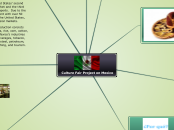Culture Fair Project on Mexico
What do we already know about Mexican culture?
Religion: Catholic
Virgin de Guadalupe
Language - Verbal
Social Organizations
Family - Family oriented; Elderly are viewed as valuable; Family comes first.
Arts, Play and Recreation
Dia de los Muertos
Pottery
Cantinfla
Material Culture
What would we like to learn?
Education Systems
Political Structure
& Government Structures
Economic Organization
Culture and Warfare
Social Control and Kinship
WHAT WE LEARNDED!!!
Nonverbal and Language Communication
Eye contact between two men is considered aggression while eye contact between a man and a woman is considered flirthing.
There are over 100 different Native American languages in Mexico; however, after the Spanish control of Mexico, Spanish became the official language.
EDUCATION
The Mexican educational system consists of three levels: primary, secondary, and higher education.
Lower-Secondary Education is compulsory, free and allows students to either follow an academic track generally continued into upper secondary schooling or a technical track with a strong emphasis on vocational, commercial and artistic training.
Upper-Secondary Education schools offer two degree tracks are thus usually affiliated with large public universities or SEP or state-controlled colleges, private school, preparatory schools or private schools.
Economic Organization
Mexico is the United States’ second greatest export market and the third greatest source of imports. Due to the free trade agreement with over 50 countries including the United States, Mexico has several markets.
Their agriculture production consists mainly of coffee, beans, rice, corn, cotton, fruits, and wheat. Mexico’s industries include: food and beverages, tobacco, chemicals, iron and steel, petroleum, mining, textiles, clothing, and tourism.
Arts
Some of the more important forms of art oresent within Mexican culture include artesania, handcrafts and folk art for utilitarian and decorative purposes, ceramics and pottery with Talavera being the most difficult to create, murals depicting a political or social message, and Papel picado for decortation used during festivities.
Social Organization
In Mexican cultures, family is at the center of social structure. . As far as the hierarchy within families and society, people respect others with authority and look to those for guidance and decision making. Furthermore, Mexicans are highly aware of how members in society fit into a certain hierarchy and thus respect those in a higher rank than themselves. It is considered highly disrespectful to break the chain of hierarchy.
Conflict and Warfare
Their current warfare is their war against drugs. Drug cartels are swarming Mexico due to its ports, corruption, and proximity to the US. While the Mexican government claims to have made progress of cracking down on the drug situation, police can be bought.
Material Culture
Today, Mexican food is tied to their agriculture and geographical location. It features diets that are centered on maize, beans, avocados, tomatoes, and chilies.
Sombreros, associated with Mexican culture since the 15th Century, are meant to protect people from the hot Mexican sun. Sombrero comes from the Spanish word, sombra meaning shade
One of the most well known weapons created by the Aztec was the maquahuitl.
Mexico homes are different throughout the different areas and include apartments, modern homes, and resorts.
The underground train is the most commonly used form of transportation at $2.00 pesos per ticket or about $.14 USD. The bus system comes in second at $5 pesos per trip or about $.36 USD.
Social Control
Mexico is a federal republic and has a president who is elected by the majority vote. The term of the president in Mexico is 6 years. Mexico has a civil law system which demonstrates the influence of the US.
Religion
About 89% of the Mexican population is Roman Catholic. Religion plays a strong part in their daily lives. As Lorena Ponce told us in our interview, it is unlikely that you will find a home in Mexico without a Crucifix prominently displayed.
Why did we choose Mexico?
We have a personal connection to Hispanic culture.
The majority of the students in our class are primarily of Mexican decent.









